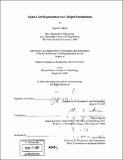Spinal cord regression via collagen entubulation
Author(s)
Matin, Sajjad S. (Sajjad Shaikh), 1979-
DownloadFull printable version (7.784Mb)
Other Contributors
Massachusetts Institute of Technology. Dept. of Aeronautics and Astronautics.
Advisor
Myron Spector.
Terms of use
Metadata
Show full item recordAbstract
(cont.) days) post-implantation. Histological and immunohistochemical analyses showed severe fibrous and glial scar formation in Groups I and III, less fibrous scarring in Group II and very little scar manifesting in Groups IV and V. A quantitative analysis of myelinated axons in the center of the explants corresponded with the assessment of scar as a physical barrier to competent axon growth. Groups I and III exhibited the least regenerated axons, Groups IV and V the most. The findings also validated the effectiveness of the dorsal barrier in promoting spinal cord regeneration. Overall, the combination of wrap membrane and dorsal barrier (Group V) proved most effective in creating a hospitable environment for regenerative success. Traumatic injury to the adult mammalian spinal cord results in varying degrees of lost motor and sensory nerve function. Damaged axons of the central nervous system (CNS) exhibit a severely limited regenerative capacity; paralysis induced by severe trauma is generally permanent. Previous studies have attempted to simulate the peripheral nerve environment, where axonal regeneration is spontaneous, through the implantation of peripheral nerve graft tissue, exogenous growth factors or prosthetic devices. Such intervention has demonstrated the ability of central nerve axons to regrow over significant distances and partially restore distal limb function. The current work aims at evaluating the efficacy of two distinct collagen implants towards promoting spinal cord regeneration. The experimental spinal lesion is a 5mm mid-thoracic gap created by transections at T7 and T9 and removal of intermediary cord and peripheral roots. The two implants offered different entubulation schemes; one implant was a thin walled tube composed of Type I bovine collagen, the other a commercially available bilayered membrane composed of Types I and III porcine collagen. Whereas the tube was fitted directly into the spinal lesion, the membrane was wrapped around the cord stumps like a tubular bandage. Five experimental groups defined the current research: Groups I and II received no implant, Groups III and IV were implanted with tubes, and Group V was implanted with the membrane wrap. A secondary aim of the research was to validate the use of a dorsal barrier in further reducing scar infiltration to the wound. This additional collagen membrane was simply draped over the implant (or lesion) of Groups II, IV and V. Mid-thoracic spinal cord sections were explanted from all groups 4 weeks (28
Description
Thesis (S.M.)--Massachusetts Institute of Technology, Dept. of Aeronautics and Astronautics, 2004. Includes bibliographical references (leaves 51-57).
Date issued
2004Department
Massachusetts Institute of Technology. Department of Aeronautics and AstronauticsPublisher
Massachusetts Institute of Technology
Keywords
Aeronautics and Astronautics.